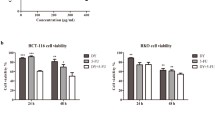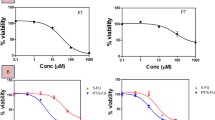Abstract
5-Fluorouracil (5-FU) alone or in combination with other drugs is the main basis of chemotherapeutic treatment in colorectal cancer although patients with microsatellite instability generally show resistance to 5-FU treatment. The present investigation is focussed on the mechanistic insight of a pure herbal carbazole alkaloid, mahanine, as a single or in combination with 5-FU in colon cancer. We demonstrated that mahanine-induced apoptosis involved reactive oxygen species (ROS)-mediated nuclear accumulation of PTEN and its interaction with p53/p73. Mahanine and 5-FU in combination exerted synergistic inhibitory effect on cell viability. This combination also enhanced ROS production, increased tumour suppressor proteins and suppressed chemo-migration. Taken together, our results revealed that mahanine can be a potential chemotherapeutic agent with efficacy to reduce the concentration of toxic 5-FU in colon cancer.








Similar content being viewed by others
Change history
28 February 2024
This article has been retracted. Please see the Retraction Notice for more detail: https://doi.org/10.1007/s10495-024-01951-8
References
Haggar Fatima A, Boushey Robin P (2009) Colorectal cancer epidemiology: incidence, mortality, survival, and risk factors. Clin Colon Rectal Surg 22(4):191–197
Westra JL, Plukker JT, Buys CH, Hofstra RM (2004) Genetic alterations in locally advanced stage II/III colon cancer: a search for prognostic markers. Clin Colorectal Cancer 4(4):252–259
Söreide K, Janssen EA, Söiland H, Körner H, Baak JP (2006) Microsatellite instability in colorectal cancer. Br J Surg 93:395–406
Harms K, Nozell S, Chen X (2004) The common and distinct target genes of the p53 family transcription factors. Cell Mol Life Sci 61(7–8):822–842
Zawacka-Pankau J, Kostecka A, Sznarkowska A, Hedström E, Kawiak A (2010) p73 tumor suppressor protein A close relative of p53 not only in structure but also in anti-cancer approach? Cell Cycle 9(4):720–728
Yin Y, Shen WH (2008) PTEN: a new guardian of the genome. Oncogene 27(41):5443–5453
Li XH, Zheng HC, Takahashi H, Masuda S, Yang XH, Takano Y (2009) PTEN expression and mutation in colorectal carcinomas. Oncol Rep 22(4):757–764
de la Cruz-Morcillo MA, Valero ML, Callejas-Valera JL, Arias-González L, Melgar-Rojas P, Galán-Moya EM, García-Gil E, García-Cano J, Sánchez-Prieto R (2012) p38MAPK is a major determinant of the balance between apoptosis and autophagy triggered by 5-fluorouracil: implication in resistance. Oncogene 31(9):1073–1085
Ruzzo A, Graziano F, Loupakis F, Santini D, Catalano V, Bisonni R, Ficarelli R, Fontana A, Andreoni F, Falcone A, Canestrari E, Tonini G, Mari D, Lippe P, Pizzagalli F, Schiavon G, Alessandroni P, Giustini L, Maltese P, Testa E, Menichetti ET, Magnani M (2008) Pharmacogenetic profiling in patients with advanced colorectal cancer treated with first-line FOLFIRI chemotherapy. Pharmacogenomics J 8:278–288
Sinicrope FA, Sargent DJ (2012) Molecular pathways: microsatellite instability in colorectal cancer: prognostic, predictive, and therapeutic implications. Clin Cancer Res 18(6):1506–1512
Kodach LL, Bos CL, Durán N, Peppelenbosch MP, Ferreira CV, Hardwick JC (2006) Violacein synergistically increases 5-fluorouracil cytotoxicity, induces apoptosis and inhibits Akt-mediated signal transduction in human colorectal cancer cells. Carcinogenesis 27(3):508–516
Ramsewak RS, Nair MG, Strasburg GM, DeWitt DL, Nitiss JL (1999) Biologically active carbazole alkaloids from Murraya koenigii. J Agric Food Chem 47:444–447
Nakahara K, Trakoontivakorn G, Alzoreky NS, Ono H, Onishi-Kameyama M, Yoshida M (2002) Antimutagenicity of some edible Thai plants, and a bioactive carbazole alkaloid, mahanine, isolated from Micromelum minsutum. J Agric Food Chem 50:4796–4802
Ito C, Itoigawa M, Nakao K, Murata T, Tsuboi M, Kaneda N et al (2006) Induction of apoptosis by carbazole alkaloids isolated from Murraya koenigii. Phytomedicine 13:359–365
Roy MK, Thalang VN, Trakoontivakorn G, Nakahara K (2004) Mechanism of mahanine-induced apoptosis in human leukemia cells (HL-60). Biochem Pharmacol 67:41–51
Sinha S, Pal BC, Jagadeesh S, Banerjee PP, Bandyopadhaya A, Bhattacharya S (2006) Mahanine inhibits growth and induces apoptosis in prostate cancer cells through the deactivation of Akt and activation of caspases. Prostate 66:1257–1265
Roy MK, Thalang VN, Trakoontivakorn G, Nakahara K (2005) Mahanine, a carbazole alkaloid from Micromelum minutum, inhibits cell growth and induces apoptosis in U937 cells through a mitochondrial dependent pathway. Br J Pharmacol 145:145–155
Bhattacharya K, Samanta SK, Tripathi R, Mallick A, Chandra S, Pal BC, Shaha C, Mandal C (2010) Apoptotic effects of mahanine on human leukemic cells are mediated through crosstalk between Apo-1/Fas signaling and the Bid protein and via mitochondrial pathways. Biochem Pharmacol 79:361–372
Sarkar S, Dutta D, Samanta SK, Bhattacharya K, Pal BC, Li J, Datta K, Mandal C, Mandal C (2013) Oxidative inhibition of Hsp90 disrupts the super-chaperone complex and attenuates pancreatic adenocarcinoma in vitro and in vivo. Int J Cancer 132(3):695–706
Samanta SK, Dutta D, Roy S, Bhattacharya K, Sarkar S, Dasgupta AK, Pal BC, Mandal C, Mandal C. (2013) Mahanine, A DNA Minor Groove Binding Agent Exerts Cellular Cytotoxicity with Involvement of C-7-OH and -NH Functional Groups. J Med Chem. PMID: 23829449
Jagadeesh S, Sinha S, Pal BC, Bhattacharya S, Banerjee PP (2007) Mahanine reverses an epigenetically silenced tumor suppressor gene RASSF1A in human prostate cancer cells. Biochem Biophys Res Commun 362:212–217
Chou TC (2006) Theoretical basis, experimental design, and computerized simulation of synergism and antagonism in drug combination studies. Pharmacol Rev 58:621–681
Mandal C, Dutta A, Mallick A, Chandra S, Misra L, Sangwan RS et al (2008) Withaferin A induces apoptosis by activating p38 mitogen-activated protein kinase signaling cascade in leukemic cells of lymphoid and myeloid origin through mitochondrial death cascade. Apoptosis 13:1450–1464
Alter P, Herzum M, Soufi M, Schaefer JR, Maisch B (2006) Cardiotoxicity of 5-fluorouracil. Cardiovasc Hematol Agents Med Chem 4(1):1–5
Chang CT, Ho TY, Lin H, Liang JA, Huang HC, Li CC, Lo HY, Wu SL, Huang YF, Hsiang CY (2012) 5-Fluorouracil induced intestinal mucositis via nuclear factor-κB activation by transcriptomic analysis and in vivo bioluminescence imaging. PLoS One 7(3):e31808
De Angelis PM, Svendsrud DH, Kravik KL, Stokke T (2006) Cellular response to 5-fluorouracil (5-FU) in 5-FU-resistant colon cancer cell lines during treatment and recovery. Mol Cancer 5:20
Torigoe S, Ogata Y, Matono K, Shirouzu K (2009) Molecular mechanisms of sequence-dependent antitumor effects of SN-38 and 5-fluorouracil combination therapy against colon cancer cells. Anticancer Res 29(6):2083–2089
Tophkhane C, Yang SH, Jiang Y, Ma Z, Subramaniam D, Anant S, Yogosawa S, Sakai T, Liu WG, Edgerton S, Thor A, Yang X (2012) p53 inactivation upregulates p73 expression through E2F-1 mediated transcription. PLoS One 7(8):e43564
Chang CJ, Mulholland DJ, Valamehr B, Mosessian S, Sellers WR, Wu H (2008) PTEN nuclear localization is regulated by oxidative stress and mediates p53-dependent tumor suppression. Mol Cell Biol 28(10):3281–3289
Planchon SM, Waite KA, Eng C (2008) The nuclear affairs of PTEN. J Cell Sci 121:249–253
Michael D, Oren M (2002) The p53 and Mdm2 families in cancer. Curr Opin Genet Dev 12(1):53–59
Lau LM, Nugent JK, Zhao X, Irwin MS (2008) HDM2 antagonist Nutlin-3 disrupts p73-HDM2 binding and enhances p73 function. Oncogene 27(7):997–1003
Zhang N, Yin Y, Xu SJ, Chen WS (2008) 5-Fluorouracil: mechanisms of resistance and reversal strategies. Molecules 13(8):1551–1569
Vilgelm AE, Washington MK, Wei J, Chen H, Prassolov VS, Zaika AI (2010) Interactions of the p53 protein family in cellular stress response in gastrointestinal tumors. Mol Cancer Ther 9(3):693–705
Sasaki Y, Koyama R, Maruyama R, Hirano T, Tamura M, Sugisaka J, Suzuki H, Idogawa M, Shinomura Y, Tokino T (2012) CLCA2, a target of the p53 family, negatively regulates cancer cell migration and invasion. Cancer Biol Ther 13(14):1512–1521
Sankpal NV, Willman MW, Fleming TP, Mayfield JD, Gillanders WE (2009) Transcriptional repression of epithelial cell adhesion molecule contributes to p53 control of breast cancer invasion. Cancer Res 69(3):753–757
Mandal C, Pal BC, Bhattacharya K, Samanta SK, Sarkar S and Das R (2013) Process for the isolation of organic compounds useful for the treatment of cancer. US Patent 2013/0065932 A1 Pub. date, March 14
HemaIswarya S, Doble M (2006) Potential synergism of natural products in the treatment of cancer. Phytother Res. 20(4):239–249
Santandreu FM, Valle A, Oliver J, Roca P (2011) Resveratrol potentiates the cytotoxic oxidative stress induced by chemotherapy in human colon cancer cells. Cell Physiol Biochem 28(2):219–228
Hwang JT, Ha J, Park OJ (2005) Combination of 5-fluorouracil and genistein induces apoptosis synergistically in chemo-resistant cancer cells through the modulation of AMPK and COX-2 signaling pathways. Biochem Biophys Res Commun 332(2):433–440
Wang CZ, Luo X, Zhang B, Song WX, Ni M, Mehendale S, Xie JT, Aung HH, He TC, Yuan CS (2007) Notoginseng enhances anti-cancer effect of 5-fluorouracil on human colorectal cancer cells. Cancer Chemother Pharmacol 60(1):69–79
Jin HR, Zhao J, Zhang Z, Liao Y, Wang CZ, Huang WH, Li SP, He TC, Yuan CS, Du W (2012) The antitumor natural compound falcarindiol promotes cancer cell death by inducing endoplasmic reticulum stress. Cell Death Dis 3:e376
Lai D, Visser-Grieve S, Yang X (2012) Tumour suppressor genes in chemotherapeutic drug response. Biosci Rep 32(4):361–374
Song MS, Song SJ, Kim SY, Oh HJ, Lim DS (2008) The tumour suppressor RASSF1A promotes MDM2 self-ubiquitination by disrupting the MDM2-DAXX-HAUSP complex. EMBO J 27(13):1863–1874
Kodiha M, Stochaj U (2012) Nuclear transport: a switch for the oxidative stress—signaling circuit? J Signal Transduct 2012:208650
Lehman JA, Waning DL, Batuello CN, Cipriano R, Kadakia MP, Mayo LD (2011) Induction of apoptotic genes by a p73-phosphatase and tensin homolog (p73-PTEN) protein complex in response to genotoxic stress. J Biol Chem 286(42):36631–36640
Rahal OM, Simmen RC (2010) PTEN and p53 cross-regulation induced by soy isoflavone genistein promotes mammary epithelial cell cycle arrest and lobuloalveolar differentiation. Carcinogenesis 31(8):1491–1500
Hwang IT, Chung YM, Kim JJ, Chung JS, Kim BS, Kim HJ, Kim JS, Yoo YD (2007) Drug resistance to 5-FU linked to reactive oxygen species modulator 1. Biochem Biophys Res Commun 359(2):304–310
Hwang PM, Bunz F, Yu J, Rago C, Chan TA, Murphy MP, Kelso GF, Smith RA, Kinzler KW, Vogelstein B (2001) Ferredoxin reductase affects p53-dependent, 5-fluorouracil-induced apoptosis in colorectal cancer cells. Nat Med 7(10):1111–1117
Katara R, Singh N (2008) Role of p53 in transcriptional regulation of proteases in mammals. Ind J Med Paediatr Oncol 29(4):19–22
Acknowledgments
This work received financial support from CSIR-IICB, CSIR under IAP-0001, HCP004, NMITLI, TLP-004 and DBT under GAP 235, ICMR, Govt. of India. Dr. Chitra Mandal is grateful to financial support by J.C. Bose Fellowship, DST of Govt. of India and also mutual grant from ICMR and German Cancer Research Centre.
Conflict of interests
None.
Author information
Authors and Affiliations
Corresponding author
Electronic supplementary material
Below is the link to the electronic supplementary material.
10495_2013_907_MOESM2_ESM.tif
Supplementary material 2 (TIFF 192 kb) S-1 Effect of mahanine on proliferation of colon cancer cells (SW480) and African green monkey kidney cells (Vero). Cells were treated with mahanine (0-30 μM) and cell proliferation was measured by MTT assay after 48 h. Mahanine-induced growth inhibitory effect was expressed as cell viability, inferred from metabolic activity, relative to untreated controls. Data were represented as % of cell proliferation (% of MTT conversion relative to untreated control cells). Each value is the mean ± SD of three independent experiments
10495_2013_907_MOESM3_ESM.tif
Supplementary material 3 (TIFF 131 kb) S-2. p53 status in HCT116 (p53wt) and stably knockdown HCT116 (p53null) cells. p53wt and p53null cells were harvested and whole cell protein lysates were prepared for Western blot analysis with indicated antibody
10495_2013_907_MOESM4_ESM.tif
Supplementary material 4 (TIFF 1735 kb) S-3 Effect of 5-FU on cell cycle arrest of HCT116 (p53wt) and HCT116 (p53null) cells. Both the cells were treated with different concentrations of 5-FU for 24 h as indicated and cell cycle analyses were performed by flow cytometry. At lower concentration, 5-FU resulted S phase arrest in respect to untreated cells whereas at higher concentration cells were arrested in G1-S phase
10495_2013_907_MOESM5_ESM.tif
Supplementary material 5 (TIFF 314 kb) S-4. Mahanine induced upregulation of p21 and Bax. HCT116 (p53wt) and HCT116 (p53null) cells were treated with different concentrations of mahanine for 24 h as indicated. The cells were harvested and whole cell protein lysates were prepared for Western blot analysis with indicated antibodies. The presented data have been derived from three different experiments, one of which is shown here
About this article
Cite this article
Das, R., Bhattacharya, K., Sarkar, S. et al. RETRACTED ARTICLE: Mahanine synergistically enhances cytotoxicity of 5-fluorouracil through ROS-mediated activation of PTEN and p53/p73 in colon carcinoma. Apoptosis 19, 149–164 (2014). https://doi.org/10.1007/s10495-013-0907-6
Published:
Issue Date:
DOI: https://doi.org/10.1007/s10495-013-0907-6




